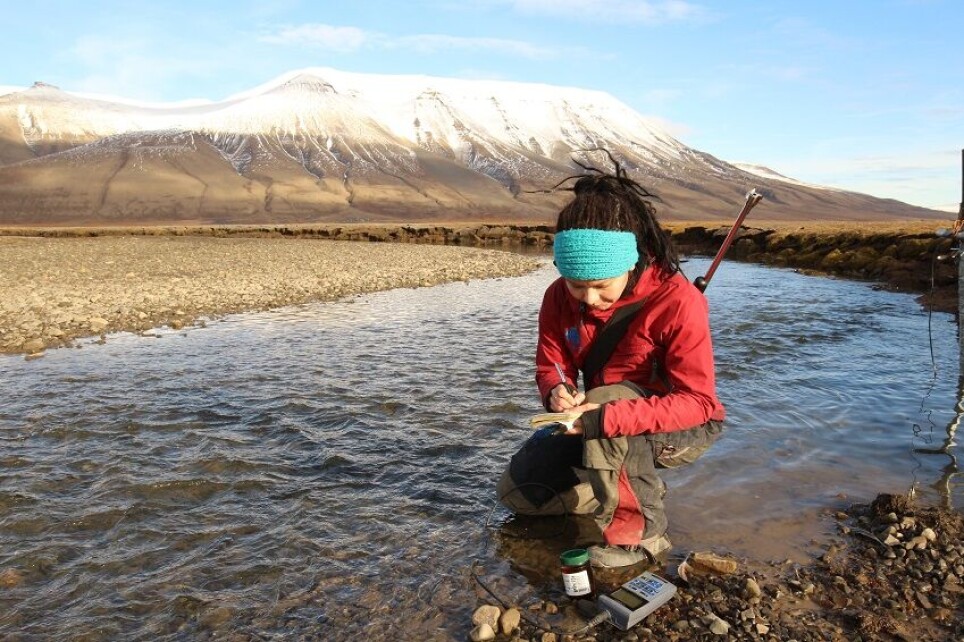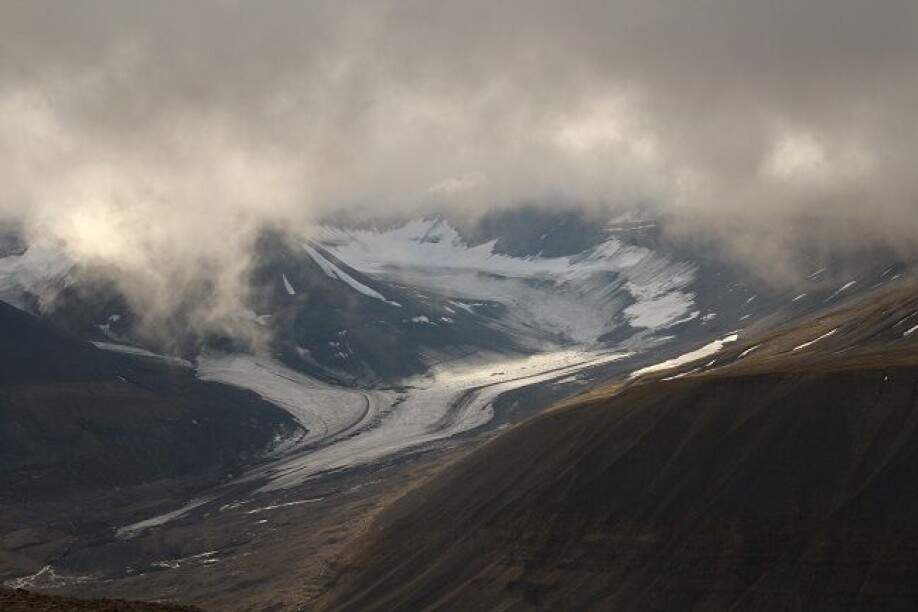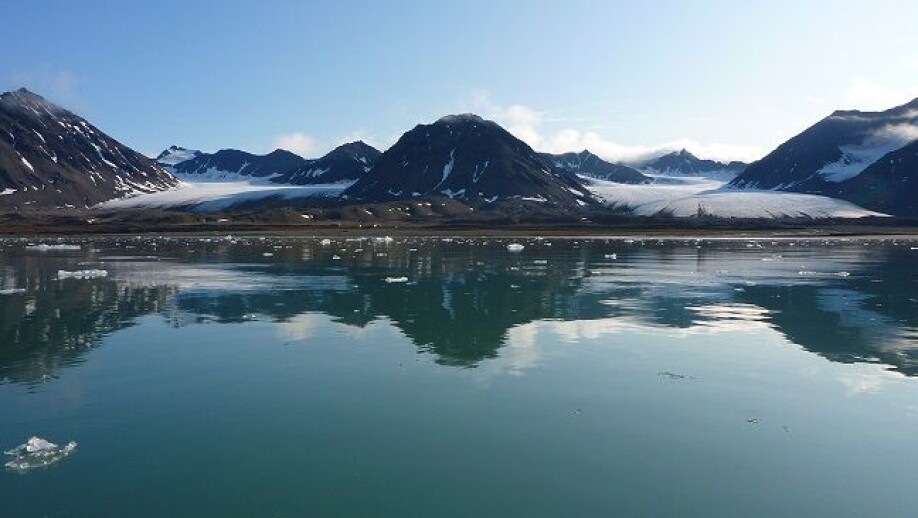THIS ARTICLE/PRESS RELEASE IS PAID FOR AND PRESENTED BY UNIS The University Centre in Svalbard - read more

“We were wrong about how fast Svalbard glaciers are melting”
Scientists call for increased research on freshwater hydrology in Svalbard, as a lot of assumed facts turn out to be outdated by many decades.
Aga Nowak is an environmental scientist specialising in hydrology and biogeochemistry. Her research focuses on investigating effects of climate change on the terrestrial and marine ecosystems in the Arctic and Antarctica.
Dr. Nowak has been performing research in Svalbard since 2009. She is now worried about the knowledge gaps still existing in the High Arctic hydrology. A big problem for Svalbard is that there is not enough information about most of the components of the water budget. There is a need for more information about precipitation, evaporation, condensation or groundwater storage and fluxes.
“In the rapidly changing climate, we don’t even know how much rainfall we have! Most, if not all, precipitation measurements are carried out at sea level. But rainfall varies with altitude as well as latitude.”
Nowak says the predicted increase in precipitation in the next 100 years for Svalbard suggested in Climate in Svalbard 2100 Report can be even up to 65%. But the problem is – the scientists don’t know exactly how much of it will fall as rainfall and how much as snowfall.

We do not monitor enough, and rely too much on modelling
In Spitsbergen, there are a few meteorological stations measuring precipitation. Most of them at sea level, and all of them on the west coast. The problem is, Svalbard is a mountainous region and precipitation increases with elevation. Later in the season, rain changes into snow.
This is especially visible in the Autumn where at the sea level we experience rainfall while when we look up the mountains, we can see a very definite snow line that gets lower as we go into winter. Conditions on the west coast are also a lot different to the conditions on the much colder east coast. Therefore, precipitation data we collect on the west are not representative of the entire island of Spitsbergen.
“In addition to the east/west divide, the south warms up faster than the north. This is a complicated matter and so we must start acknowledging in our models that local climate has an effect on rainfall-snowfall patterns across Svalbard.”
For example, in the last 40 years both Hornsund and Longyearbyen have been experiencing less snowfall. But maritime Hornsund sees much more rainfall than Longyearbyen, where climate is more continental. In contrast, Ny-Ålesund located in the north part of the island has become both snowier and wetter.
With warmer weather also come changes in evaporation and condensation, two variables that we also do not measure, but rather use constants based on outdated numbers acquired 30 years ago.

Need a better understanding of the water volumes
How can we predict how much freshwater will be delivered into our fjords and the Arctic Ocean, if we don’t have a good understanding how much water is being delivered onto land?
She sighs and adds that the latest research modeling freshwater discharge based on glacier mass balance and predicted climate change suggest that we should expect continuous increase in freshwater delivery into fjords from areas covered by glaciers and no increase from areas where is no glaciers.
However, the results of those modeling studies are in contradiction with what Nowak and others discovered when they started looking at the real-life discharge data from various catchments across Svalbard from the last 50 years.
The reality was shocking, she says. A comparison of areas covered by large glaciers with those with smaller glaciers like deGeerdalen, Brøggerbreen (in Ny-Ålesund) or Waldemarbreen (in Hornsund) revealed that for over 10 years now those catchments have been producing less and less water every year – not more like predictions suggest.
Moreover, also in contradiction to the modeling studies, in areas where there are no glaciers- like for example Fuglebekken (in Hornsund) or Londonelva (in Ny-Ålesund) increase in rainfall observed across the archipelago results in consistent increase in freshwater discharge. Svalbard is getting wetter. How much longer we will be able to call it a Polar desert, she wonders.
The peak is behind us
There is a lot of out-cry for increased water discharge in Svalbard due to increase glacier melt, but Nowak says that real life data show that smaller glaciers in Svalbard have already crossed the point of no return, and definitely crossed the peak discharge years.
We can no longer expect continues increase in freshwater delivery from those areas like Longyeardalen or DeGeerdalen or Endalen as glaciers residing in those catchments have shrunk too much to sustain it. Moreover, they will continue to get thinner, and disappear.
So where can we expect that increase?
“Only huge glaciers are producing more water now as their response to climate change is much slower, and of course large catchments like Adventdalen that can collect a lot of aerial precipitation.”
Changing hydrological year
Nowak also highlights an issue with our understanding of the hydrological year. Unlike a calendar year, it is from October 1 to September 31. This is because October 1 is supposed to mark the end of the melting season.
“We assumed that all the water that is flowing would be frozen in October, and the precipitation would fall as snow and be on the ground until it is melted in May.”
“What we’ve discovered with climate change in Svalbard is that we still see rivers flowing past October 1. Last year, Longyearelva was still flowing on October 20. There was rainfall in October and November producing freshwater discharge into Adventfjorden.”
She says we need to start rethinking our approach to our understanding of what hydrological year is on Svalbard.
“Our world is changing fast. The melt starts earlier, and water freezes up later. Our old approaches to measuring the water balance, that worked for 50 years, need to be adjusted to new conditions.”
The story of water in Svalbard does not end with glaciers.
Freshwater flowing from land into polar fjords delivers nutrients and sediments and so is influencing water circulation in the fjord and affects the food chain in the fjords and sea.
Nowak says that hydrological research is very limited in Svalbard. The studies are expensive, require a lot of effort as well as money and so few carry them out.
“We have just started collaboration across nations and institutions measuring water discharge. There is a lot of work in front of us.”

Lacking an overview
The mass balance studies do not give an accurate overview of the entire system. The permafrost is thawing, meaning ground thaw, and a lot of what used to be frozen can now allow for water movement and storage.
“We don’t know how much water is being stored in the ground. We don’t know how much water is in the active layer that freezes and defrosts every year. We’re in desperate need of more ground-water research.”
Nowak lists up more challenges. Modelling studies are not representative enough for the catchments in Svalbard.
Which direction are the changes going? Until now we thought that Svalbard is producing increasing amount of freshwater into polar ocean due to rapid glacier melt. We see now that this is not entirely true as many glaciers in Svalbard have already passed the point of no return, and they have been producing less and less freshwater for over 10 years now.
Nowak calls for increased cooperation with NVE and NP, as well as research across disciplines and nations.
“We have a dire need for integrated hydrological research in Svalbard, especially the one that produces long term monitoring data.”
“Today we’re relying on equations and assumptions that were made 30 years ago. But they are not applicable any more due to climate change.”
She concludes:
“We must start acknowledging that the hydrological changes in Svalbard are much further along than we thought. We cannot replace long term monitoring with computer models.”
Reference:
Aga Nowak et.al.: From land to fjords: The review of Svalbard hydrology from 1970 to 2019. In: Moreno-Ibáñez et al (eds) SESS report 2020, Svalbard Integrated Arctic Earth Observing System, Longyearbyen. 2021.






































